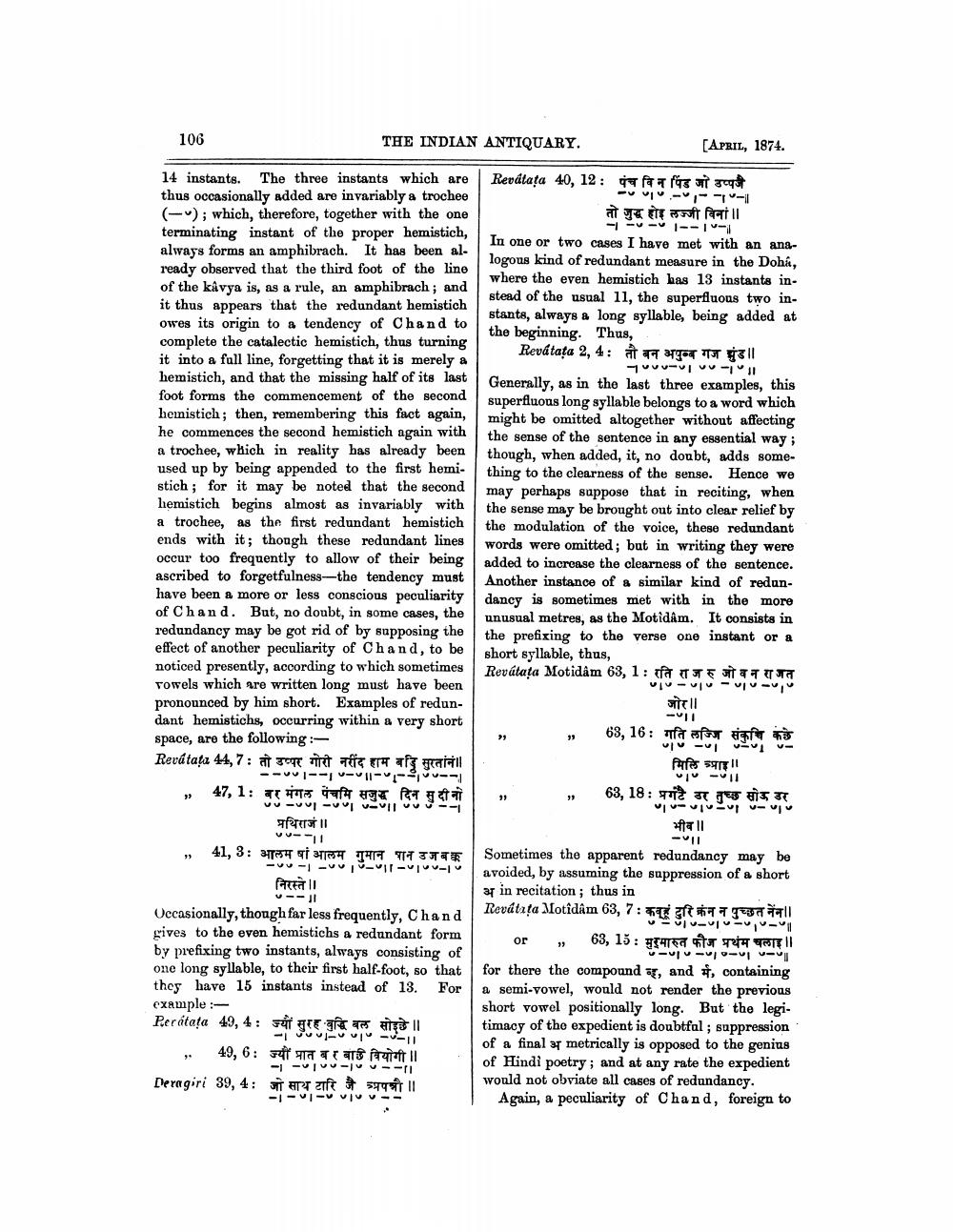________________
106
14 instants. The three instants which are thus occasionally added are invariably a trochee (); which, therefore, together with the one terminating instant of the proper hemistich, always forms an amphibrach. It has been already observed that the third foot of the line of the kavya is, as a rule, an amphibrach; and it thus appears that the redundant hemistich owes its origin to a tendency of Chand to complete the catalectic hemistich, thus turning it into a full line, forgetting that it is merely a hemistich, and that the missing half of its last foot forms the commencement of the second hemistich; then, remembering this fact again, he commences the second hemistich again with a trochee, which in reality has already been used up by being appended to the first hemistich; for it may be noted that the second hemistich begins almost as invariably with a trochee, as the first redundant hemistich ends with it; though these redundant lines occur too frequently to allow of their being ascribed to forgetfulness-the tendency must have been a more or less conscious peculiarity of Chand. But, no doubt, in some cases, the redundancy may be got rid of by supposing the effect of another peculiarity of Chand, to be noticed presently, according to which sometimes Vowels which are written long must have been pronounced by him short. Examples of redundant hemistichs, occurring within a very short space, are the following:
Revátata 44, 7 तो उप्पर गोरी नींद हाम बडि सुरतानं ॥
:
THE INDIAN ANTIQUARY.
47, 1:
"3
----11---10-
बुर मंगल पंचमिजुङ दिन सु दी नो
प्रथिराजं ॥ 47--11
41, 3: आलम षां आलम गुमान पान उजबक
111 11
41131
निरस्ते ।। Occasionally, though far less frequently, Chand gives to the even hemistichs a redundant form by prefixing two instants, always consisting of one long syllable, to their first half-foot, so that they have 15 instants instead of 13. For example:Perátata 49, 4: ज्यों सुरह बुद्धि बहु | 49, 6 ज्यों प्रात व र बाउ वियोगी ||
I
11--1-cole-1
Deragiri 39, 4: जो साथ टारि जै अपनी ॥
1111111111
[APRIL, 1874. Revalata 40, 12: पंच विन पिंड जो उप्पजै
तो जुद्ध होइ लज्जी विनां ॥
-ד- -וי- ו
In one or two cases I have met with an analogous kind of redundant measure in the Doha, where the even hemistich has 13 instants instead of the usual 11, the superfluous two instants, always a long syllable, being added at the beginning. Thus,
Revátata 2, 4: तो बन अपुब्ब गज झुंड ॥
1-1--1--|
Generally, as in the last three examples, this superfluous long syllable belongs to a word which might be omitted altogether without affecting the sense of the sentence in any essential way; though, when added, it, no doubt, adds something to the clearness of the sense. Hence we may perhaps suppose that in reciting, when the sense may be brought out into clear relief by the modulation of the voice, these redundant words were omitted; but in writing they were added to increase the clearness of the sentence. Another instance of a similar kind of redundancy is sometimes met with in the more
unusual metres, as the Motîdâm. It consists in the prefixing to the verse one instant or a short syllable, thus,
29
or
- Innat
Revátata Motidám 63, 1 रति राज रु जो वन राजत པ |པ = v|པ - པད པ -པ ཅི
sitell
-[|
68, 16: गति लज्जि संकुचि कछे
510351 v=v1
fafes say!! 410 411
:
63, 18 प्रगटै उर तुच्छ सोऊ उर པ་པ-པ་--པ་ པ- པད after 11 -v11
Sometimes the apparent redundancy may be avoided, by assuming the suppression of a short a in recitation; thus in Revátata Motidám 63, 7: कव्हूं दुरि क्रेन न पुच्छत नेंन।। པ] པ-ཅ| པ -ཅ 63, 15 मुरमारुत फौज प्रथम चलाइ ।।
In-n In-o 10-10
for there the compound ar, and #, containing a semi-vowel, would not render the previous short vowel positionally long. But the legitimacy of the expedient is doubtful; suppression of a final ar metrically is opposed to the genius of Hindi poetry; and at any rate the expedient would not obviate all cases of redundancy.
Again, a peculiarity of Chand, foreign to




